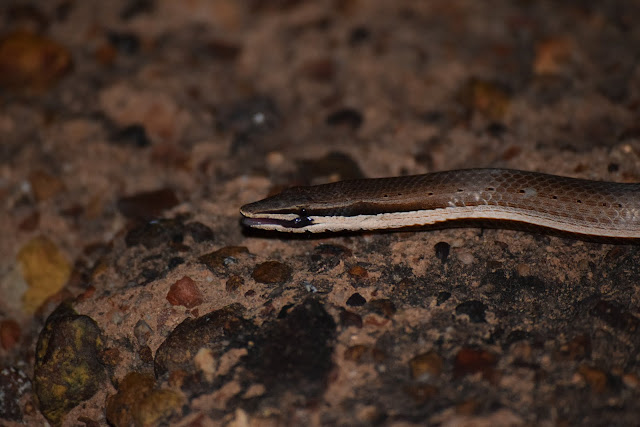Notes from the field
My wife Kelly mentioned that the picture I put up earlier of one
of my study species looks dark, foreboding, and scary. After catching eight
more last night (that makes 12 total!) I thought it would be a good idea to
snap a better pic.
 |
| Water python (Liasis fuscus) |
They’re really gentle giants (except a few nippers), and
their bellies are a beautiful yellowish tint. Not to mention I haven’t seen one
move very quick yet, so catching them is a breeze. They’re called water pythons,
but I haven’t been able to find any research on how their hydration state
fluctuates in the environment. Couple that with immune function tests as they
hydrate/dehydrate and you basically have the nuts and bolts of my water python
study.
Friendly, easy to find, and purty.
What’s not to like?
Fieldwork alone at night can sometimes be a little
lonely/terrifying.
Lucky for me there are an endless supply of critters for us
to 'ohh' and 'ahh' at.
 |
| Eastern long-necked turtle/Snake-headed turtle (Chelodina longicollis) |
People said I’d be sick of them by the end of the summer. I’m not buying it. How could you get sick of that face!?
I also found what I thought was a new snake species for the
trip…until it licked its eyeball (which is not something snakes generally do)
 |
| Tastes like chicken |
It turned out to be one of the first lizards I’ve seen all
trip except for a million and a half skinks that I can’t seem to identify or
get a good picture of.
Most people think the identifying feature of a snake is a lack of limbs.
Au contraire.
There are actually many species of legless lizards that look just like snakes. It isn't easy to find any hard and fast rule but generally if it has closeable eyelids, ear holes, or can lick it's eyeball with its tongue...it's a lizard.
 |
| Burton’s legless lizard (Lialis burtonis) |
I kept running into this little guy and couldn’t help
myself. I had to take a photo and share it. He reminds me of Harry's owl Hedwig.
(I’m pretty sure I just
scored double on the nerd scale: bird picture and Harry Potter reference...winning!)
 |
| Tawny frogmouth (Podargus strigoides) |
Even when there aren’t any birds, snakes or lizards out, the
country is incredibly rich and beautiful. The wild is often all consuming.
Everywhere you look
there’s something new to find or cool to look at.
 |
| Praying mantis |
The praying mantis is a pretty awesome as far as insects go. It can turn its
head like a human (which is cool and creepy to see at the same time), most
insects can’t because of their stiff necks. It has a pretty bizarre love-life in certain
situations, although it’s only a myth that females bite the heads off their
partners every time. Most insects only
sense vibrations to hear but mantids actually have an ear (just a single) on
the middle of their abdomen (belly), that can sense the high pitched tones of bats. They also have modified front legs that are super strong and spikey to
hold onto prey.
I think they make a pretty good case for coolest insect around.
Like the long-necked turtle, I don’t ever think I’ll get
tired of seeing the friendly treefrogs that love to hang out around the lab
buildings at night
 |
| Smile on Dumpy |
Of course field work/tropical living wouldn’t be complete if I didn’t come home to a
giant insect on my pillow!
 |
| Goodnight dragonfly |
During the day I spent most of my time on my experiments
including processing some more children’s pythons. I honestly can’t understand
why people are so scared of snakes. Granted, I’m not going to jump on an olive
python anytime soon, but children’s are about the tamest wild animal I’ve ever
encountered.
 |
| Coiled up for a nap |
This little lady was on the counter after I measured her
length and was recording notes. Instead of trying to dart away she
started moving into my pocket. Rather than discourage such behavior, I was all
too happy to oblige her a short nap.
Near and dear to my heart indeed.
Normally when I work with these animals at ASU I have an
army of eager undergraduate researchers to help hold them and take
measurements. Figuring out how to get a blood sample with only two hands while
also keeping them stable was quite a conundrum.
This is jungle science though
and the motto is ‘make do with what you’ve got’.
My father always imparted on me that there are certain household
items that have never ending value.
 |
| Duct tape, a million uses and counting |
No comments:
Post a Comment